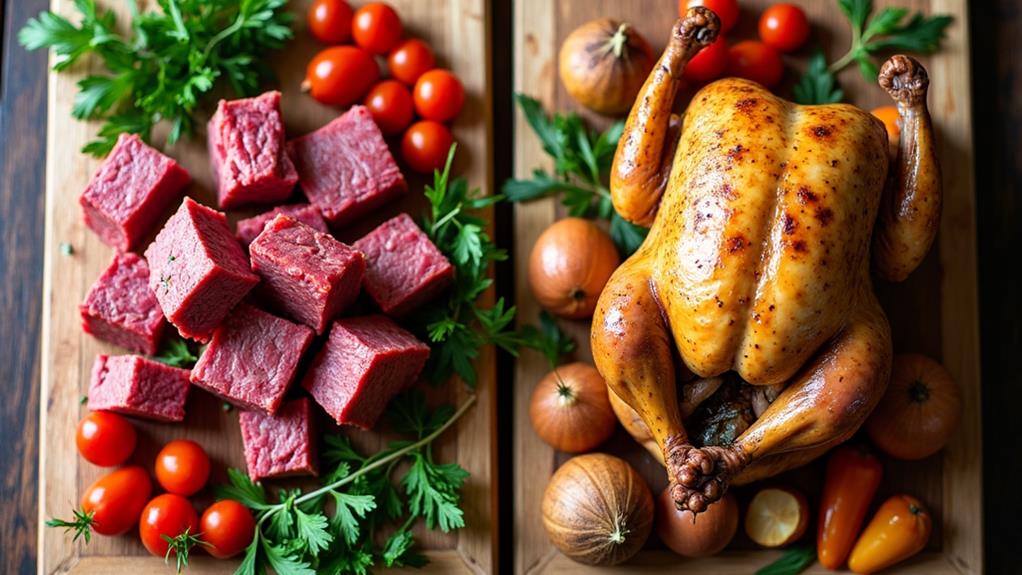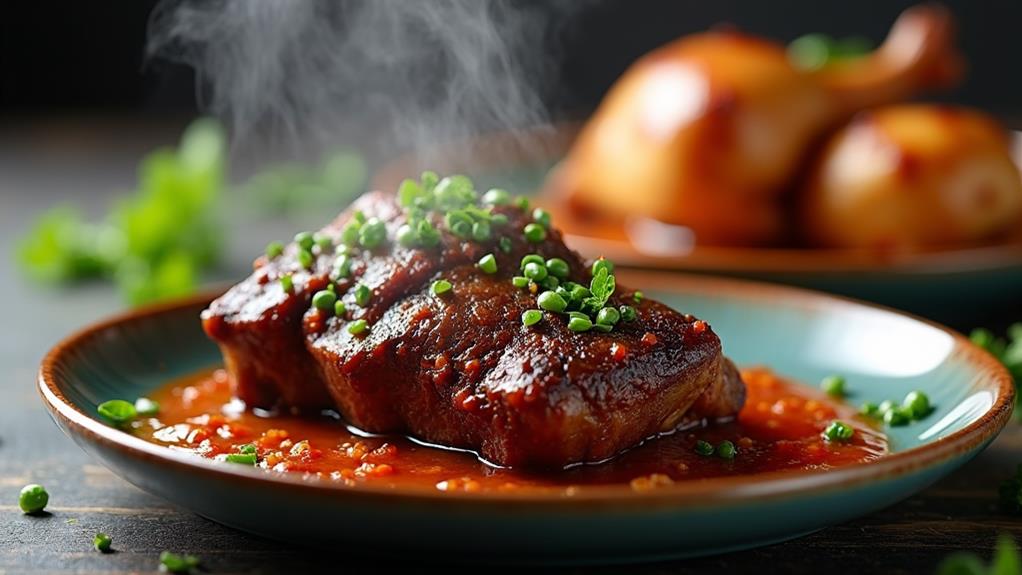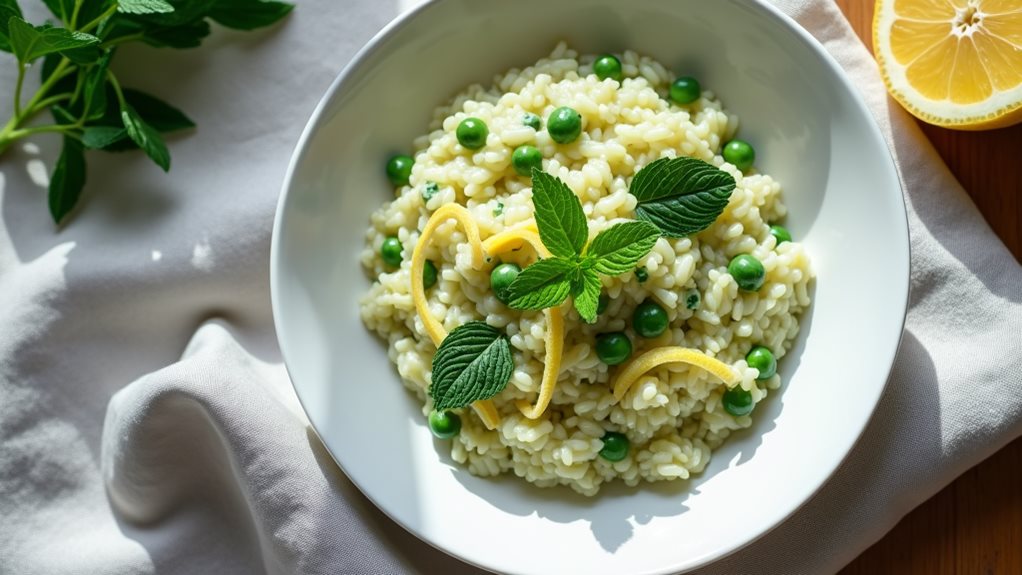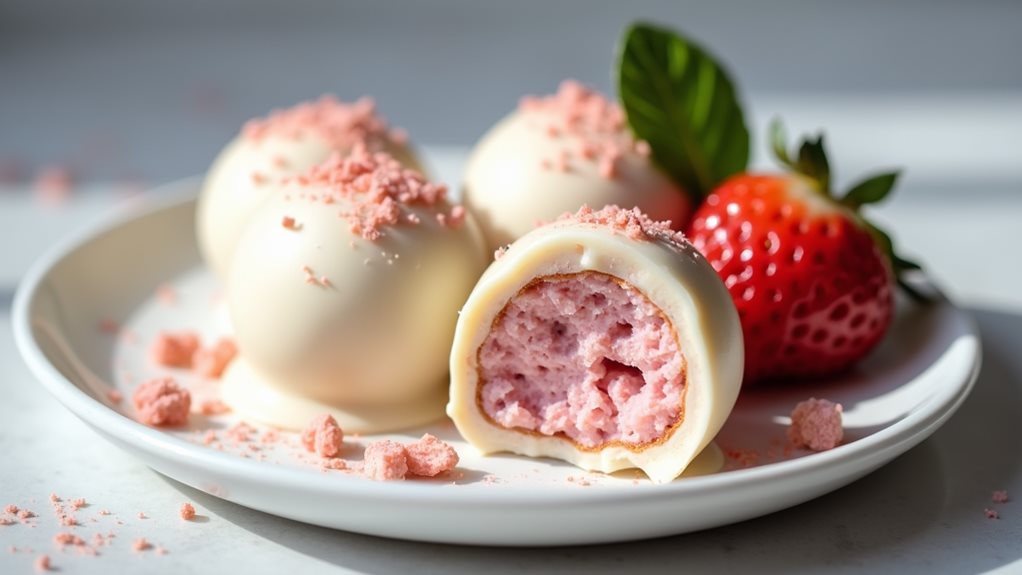Braising and roasting offer distinct flavor profiles and textures in your culinary arsenal. Braising uses moist heat, combining searing and slow cooking in liquid, resulting in tender, flavorful dishes. It's ideal for tough cuts of meat, breaking down fibers and infusing flavors. Roasting, on the other hand, relies on dry heat convection, creating a crispy exterior while maintaining interior juiciness. It's perfect for tender meats and vegetables, developing rich, savory profiles through surface browning. Both techniques employ the Maillard reaction for complex flavors, but braising yields fall-apart tenderness while roasting provides contrasting textures. Understanding these methods will elevate your cooking skills and expand your recipe repertoire.
Heat Transfer in Culinary Techniques
Heat transfer forms the foundation of cooking methods like braising and roasting. When you're in the kitchen, you're not just preparing food; you're orchestrating a complex dance of thermal energy.
In both techniques, you'll harness different heat transfer mechanisms to transform raw ingredients into culinary masterpieces. Braising short ribs, for example, highlights the importance of slow cooking to achieve tender meat and a rich sauce, enhancing flavor key elements of braised short ribs.
Roasting primarily relies on convection principles, where hot air circulates around the food, creating a crisp exterior while maintaining a juicy interior. You'll find this method ideal for larger cuts of meat or whole vegetables, as it allows for even cooking and beautiful browning.
On the other hand, braising combines multiple conduction methods. It starts with a quick sear, utilizing direct heat transfer from the pan to the food's surface. Then, you'll immerse the partially cooked ingredient in liquid, where heat is conducted through the cooking medium.
This slow, moist-heat method breaks down tough fibers in meats and infuses flavors deeply into the dish. By understanding these heat transfer mechanisms, you'll be able to innovate and adapt your cooking techniques, elevating your culinary creations to new heights.
Flavor Development and Maillard Reaction
When you're braising or roasting, you'll notice the development of rich flavors through a process called the Maillard reaction.
This chemical reaction between amino acids and sugars creates complex flavors and aromas, resulting in the familiar brown color and savory taste of cooked meats and vegetables.
As the food cooks, you'll observe caramelization and browning, which contribute to a deeper, more intense flavor profile that enhances the overall taste experience.
Caramelization and Browning
One of the key differences between braising and roasting lies in their approach to caramelization and browning. When you're roasting, you're exposing food to dry, high heat, which triggers intense browning reactions on the surface. This process, known as the Maillard reaction, creates complex flavors and that coveted golden-brown crust.
You'll notice this especially on meats and vegetables, where the exterior becomes crisp and flavorful. Similarly, the creation of a savory bread pudding highlights this aspect of cooking, as the golden-brown top signals readiness and adds depth to the dish savory flavor techniques.
In contrast, braising relies on moist heat and lower temperatures, which limits surface browning but promotes internal caramelization. As you braise, sugars in the food slowly break down, creating rich, deep flavors throughout the dish. This caramelization technique is particularly effective for tough cuts of meat, transforming them into tender, flavorful masterpieces.
To maximize browning in braising, you can sear ingredients before adding liquid. This initial high-heat step creates a flavor-packed foundation for your braise.
Depth of Flavor
Building on the concept of caramelization, let's explore the depth of flavor achieved through braising and roasting. Both techniques unlock a treasure trove of taste, but they do so in distinct ways.
When you roast, you're harnessing the power of dry heat to create complex flavors through the Maillard reaction. This process transforms proteins and sugars, resulting in a rich, savory profile that's hard to replicate. You'll notice this in the crispy exterior of roasted meats or vegetables, similar to the robust flavors found in dishes like Slow Cooker Chili Con Carne, where browning the beef enhances its overall taste.
Braising, on the other hand, is a wet-heat method that excels at extracting and melding flavors. As you simmer ingredients in liquid, you're creating an environment ripe for herb infusion and spice layering.
The low, slow cooking allows flavors to meld and intensify, producing a harmonious blend that permeates the entire dish. You'll find that braised foods often have a more nuanced taste profile, with each bite offering a symphony of flavors.
Texture and Tenderness Outcomes

The texture and tenderness outcomes of braising and roasting differ significantly. When you braise, you're embracing moisture retention, resulting in incredibly tender cuts that practically melt in your mouth. The slow, moist cooking process breaks down tough connective tissues, transforming even the most stubborn cuts into succulent delights.
Roasting, on the other hand, creates a different texture profile. You'll achieve a crispy exterior with a juicy interior, perfect for tender cuts that don't require extensive tenderizing.
Consider these key differences:
- Braising yields fall-apart tenderness
- Roasting produces a satisfying contrast of textures
- Braised meats often have a velvety mouthfeel
For innovative cooks, understanding these texture outcomes opens up a world of culinary possibilities. You can strategically choose your cooking method based on the desired final texture.
Braising is ideal for tough cuts like brisket or short ribs, while roasting works wonders for tender cuts like prime rib or chicken breasts. By mastering both techniques, you'll elevate your cooking game and create dishes that not only taste amazing but also boast the perfect texture every time.
Time Management in Meal Preparation
When you're juggling multiple tasks in the kitchen, efficient prep techniques can make a world of difference in your meal preparation.
You'll want to consider strategies like chopping all your vegetables at once, measuring out ingredients beforehand, and utilizing any idle time during cooking to clean up or set the table.
Efficient Prep Techniques
Mastering efficient prep techniques can make or break your braising and roasting experiences. To streamline your cooking process, start with ingredient organization.
Set up dedicated prep stations for different tasks, ensuring all necessary items are within arm's reach. This approach minimizes time wasted searching for utensils or ingredients, allowing you to focus on the culinary task at hand.
Embrace these innovative prep techniques to elevate your cooking game:
- Batch prep ingredients for multiple meals, saving time throughout the week
- Utilize multi-tasking tools like food processors for quick vegetable chopping
- Implement the "mise en place" method, arranging all ingredients before cooking begins
Multitasking Cooking Strategies
Along with efficient prep techniques, mastering multitasking strategies is crucial for successful braising and roasting. To optimize your cooking efficiency, start by organizing your recipes and creating a detailed meal prep plan. This allows you to streamline your kitchen workflow and tackle multiple tasks simultaneously.
Implement multitasking methods like preheating your oven while chopping vegetables, or marinating meat as you prepare other ingredients.
Improve your cooking efficiency by sourcing ingredients strategically. Group similar items together and plan your shopping trips to minimize time spent gathering supplies.
In the kitchen, set up multiple workstations to handle different aspects of your recipes concurrently. For instance, while your roast is in the oven, you can prepare the braising liquid and cut vegetables for your braised dish.
Utilize time-saving tools and appliances to further enhance your multitasking abilities. Slow cookers, pressure cookers, and food processors can significantly reduce hands-on cooking time, allowing you to focus on other tasks.
Selecting and Preparing Ingredients

Selecting the right ingredients is crucial for both braising and roasting. Your ingredient selection can make or break your dish, so it's essential to choose wisely. When it comes to braising, opt for tougher cuts of meat that'll benefit from low, slow cooking. For roasting, select ingredients that can withstand high heat and develop a delicious crust.
Consider these factors when preparing your ingredients:
- Size and uniformity: Cut ingredients into similar-sized pieces for even cooking
- Seasoning: Apply herbs and spices generously to enhance flavor
- Marinating: Allow time for flavors to penetrate before cooking
Flavor pairing is key to creating innovative dishes. Experiment with complementary tastes and textures to elevate your culinary creations. Don't be afraid to combine unexpected ingredients; this is where true innovation happens.
When preparing vegetables for braising or roasting, clean them thoroughly and trim any unwanted parts. For meats, remove excess fat and pat dry to encourage browning.
Essential Equipment and Pairing Considerations
Once you've chosen your ingredients, it's time to focus on the tools and pairings that'll elevate your braising or roasting experience. For braising, you'll need a heavy-bottomed pot with a tight-fitting lid, such as a Dutch oven or a braiser. These cooking vessels retain heat well and allow for even distribution of flavors.
When roasting, opt for a sturdy, shallow roasting pan that can withstand high temperatures.
Your seasoning choices play a crucial role in both methods. For braising, experiment with bold herbs like rosemary, thyme, and bay leaves, which infuse the liquid and meat with rich flavors.
Roasting calls for a different approach; try creating herb rubs or marinades that'll form a flavorful crust on the exterior of your meat or vegetables.
Don't forget about complementary side dishes. Braised meats pair well with creamy polenta or mashed potatoes to soak up the delicious sauce.
Roasted dishes shine alongside crisp salads or roasted vegetables that echo the caramelized notes of the main course.
Frequently Asked Questions
Can You Braise or Roast Frozen Meat?
You can braise or roast frozen meat, but you'll need to adjust cooking times. It's not ideal, though. For optimal results and food safety, thaw your meat first. Experiment with quick-thaw methods to streamline your innovative cooking process.
Are Braising and Roasting Suitable for Vegetarian or Vegan Dishes?
Like a garden blooming with possibilities, you'll find braising and roasting perfect for vegetarian adaptations and vegan variations. You can transform hearty veggies into mouthwatering dishes, unlocking new flavors and textures that'll revolutionize your plant-based culinary repertoire.
How Do Braising and Roasting Affect the Nutritional Value of Food?
You'll find both braising and roasting can impact nutrition. They'll enhance flavors while potentially reducing some nutrients. However, they'll also boost antioxidants and make certain nutrients more bioavailable. It's a trade-off for innovative, flavorful cooking.
Which Method Is More Energy-Efficient: Braising or Roasting?
Picture your kitchen abuzz with culinary innovation. You'll find braising more energy-efficient than roasting. It uses less energy consumption due to lower temperatures and shorter cooking time. Embrace this method to revolutionize your sustainable cooking approach.
Can Braising and Roasting Techniques Be Combined in a Single Dish?
You can definitely combine braising and roasting in one dish. Start by roasting to develop a crispy exterior, then braise to infuse flavors. This innovative approach creates a delightful texture contrast and deep flavor infusion. Get creative!
Final Thoughts
As you've journeyed through the culinary realms of braising and roasting, you've uncovered the secrets that make each technique unique. You've learned how heat transforms ingredients, develops flavors, and affects textures. Armed with this knowledge, you're now equipped to choose the perfect method for your next meal. Whether you're braising a succulent pot roast or roasting crispy vegetables, you'll create dishes that sing with flavor. So, fire up your oven or pull out that Dutch oven – your taste buds await!















